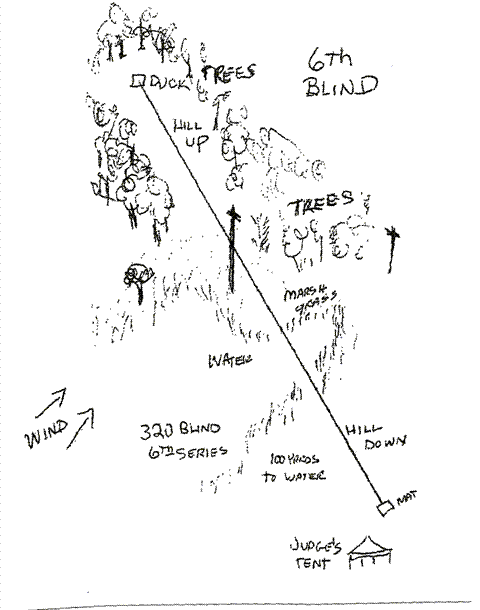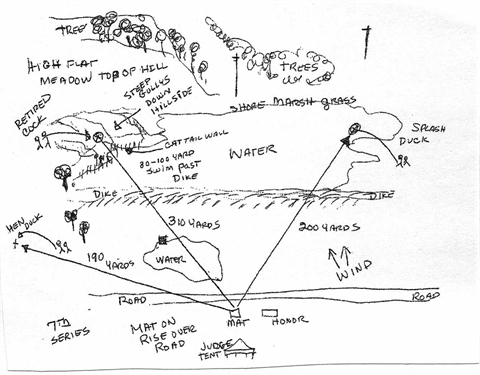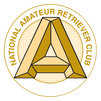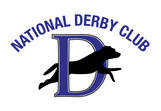Thursday, November 16, 2000 |
Finish 5th, 6th and Start 7th
Thursday's weather was sunny, windy and milder than Wednesday. The five remaining dogs completed the fifth about 8:30 a.m. The Quad had taken a toll - 45 dogs remained. Fifteen more had been lost. They were: 6, 11, 15, 17, 18, 19, 28, 30, 42, 51, 52, 53, 67, 75, and 86. The sixth would be initiated by dog # 71.
Sixth Series - Land /Water Blind
By shortly after 9 a.m. the Sixth series, an approx. 300 yd. land/water blind was ready to run. The line was located on top of a hill and had a long entry - about 100 yds- then continued (parallel) along the running, marshy shoreline with some swimming water (about 100 yds.) to the land beyond. There it continued for another 100 yds over rising terrain (tree studded). The handler was allowed to move up to a ribbon so he could see the dog go down the hill and (hopefully) enter the water below. (Water unseen from line) A strong wind switched from down to crosswind . Trees, wind and terrain made it difficult to keep dogs on line ( However it was reported that Lean Mac had only 1 whistle!) Number Six went relatively quick and was completed by 12:30 p.m. Afterwards callbacks listed only 37 dogs back to the Seventh - a land (some water) triple in the same area. Eight had succumbed to the sixth. They were: 3, 4, 5, 40, 58, 64, 84 and 85.
Seventh Series - Land Triple
Again, it was not necessary to move so the test was set up in good time. Dog 87 would be first to run. The test utilized some of the land from the previous test. The series contained a shot flying mallard and a retired gun. The first bird down, a dead drake, was on the right. It was thrown left where it landed on the line to the previous blind about 225 yds from the line splashing into a marshy area. The second mark was in the middle . Gunners were on top of a hill which had a steep bank with gullies running through it. They threw a dead cock rooster flat toward the right. It fell behind a room sized patch of cattails 250 yards away. The last mark was on the left. It was a flying hen mallard angled sharply back where it fell on land, across a road about 225 yards from line (no swim). As the dog was sent for it, the middle pheasant mark guns retired.
The flyer, angled sharply back caused some hunting and dimmed dog's memory of the other two. The right mark lay on line to the previous series There was a good deal of terrain (dike) where the dog could lose sight of the mark and become confused as to where it really was.. Since it was thrown left and the middle mark right, the middle ground between the two could tempt dogs to hunt behind the gun. A switching or downwind did not make it any easier. The most difficult mark, of course, was the long middle retired pheasant. To recover it, dogs had to go through two ponds and over a dike from one to another. There they went out of sight for a period of time and could reappear well off line. If the dog stayed in the water they could find the bird. Dogs that skirted to the left and drove up the hill were usually lost. There they seemed to be unable to hear the whistles and could not be handled to the bird. At times a glare from the water made the marks difficult to see. Generally, handlers took the outside birds first.
Lean Mac provided unintentional entertainment during his turn. After being released to retrieve, Judges decided to call a no-bird and rerun him. Maxx, perhaps slightly deaf and intent on the retrieve, just continued hunting. Handler Mike Lardy tried everything - voice, "body language", etc. to get him back before finally succeeding. Later, when he finally completed his series, a wing covered his eyes and he headed toward the gallery and other places trying to locate Mike. On the way he offered his bird to several people on the gallery path before finally making his way back to Mike.
The demanding triple took 12-15 minutes per dog and could not be completed by dusk. The test was suspended after #37 ran and will resume at 7 a.m Friday. So far only a few dogs had done it fairly well.
The flyer, angled sharply back caused some hunting and dimmed dog's memory of the other two. The right mark lay on line to the previous series There was a good deal of terrain (dike) where the dog could lose sight of the mark and become confused as to where it really was.. Since it was thrown left and the middle mark right, the middle ground between the two could tempt dogs to hunt behind the gun. A switching or downwind did not make it any easier. The most difficult mark, of course, was the long middle retired pheasant. To recover it, dogs had to go through two ponds and over a dike from one to another. There they went out of sight for a period of time and could reappear well off line. If the dog stayed in the water they could find the bird. Dogs that skirted to the left and drove up the hill were usually lost. There they seemed to be unable to hear the whistles and could not be handled to the bird. At times a glare from the water made the marks difficult to see. Generally, handlers took the outside birds first.
Lean Mac provided unintentional entertainment during his turn. After being released to retrieve, Judges decided to call a no-bird and rerun him. Maxx, perhaps slightly deaf and intent on the retrieve, just continued hunting. Handler Mike Lardy tried everything - voice, "body language", etc. to get him back before finally succeeding. Later, when he finally completed his series, a wing covered his eyes and he headed toward the gallery and other places trying to locate Mike. On the way he offered his bird to several people on the gallery path before finally making his way back to Mike.
The demanding triple took 12-15 minutes per dog and could not be completed by dusk. The test was suspended after #37 ran and will resume at 7 a.m Friday. So far only a few dogs had done it fairly well.










